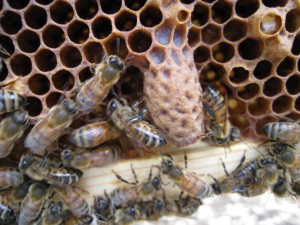I never learn
Being a pop, a gardener, a beekeeper, a blogger and an employee of Dominion pretty much requires about 40 hours a day. These 24 hour days are not working for me. Regardless, I have been juggling it about and keeping on top of my bees (I should probably say ‘abreast of my bees’, as I am rarely on top of everything that is going on with them.)
As to my last post, I did lose both the Apple Orchard Nuc and the Blue Cottage Nuc. The first Nuc came from a July swarm (and it was definitely not worth a fly). The second Nuc was one of the Nuc’s that I purchased this past Spring. It was a ‘Nuc purchasing’ lesson for me, as it came with 1.5 frames of bees/honey/pollen. I gave it some capped brood from my other hives, but it simply never could get a leg up. I am confident that the problem was with the queen. I have seen this time and time again. A weak hive simply never thrives as it has a weak queen. This may not be the holy grail (i.e. I am sure there are exceptions), but it has held true enough for me that I will not sweat a weak Nuc going forward.
The combine with Moe and Apache worked like a champ. I think that queen went into a laying frenzy after the combine, but I have no hard data to prove it. I definitely found a ton of eggs that had been recently laid and do not recall seeing that when she was in the Nuc. I put an entrance reducer on the hive anyway, as it definitely is on the border of having too much honey to protect at the moment. I’ve been back a few times and it is all looking good.
I also moved the Berkeley Hive down to my Apiary at Haupt Store. Here is the meaning of the title of this post. I moved a strong hive down to an apiary with nothing but Nuc’s. You’d think even my small brain would work sometimes. Well, needless to say, I came back 24 hours later and found that hive attacking all of my Nuc’s. I couldn’t believe it. I blocked off the entrance and took them all down to my pop’s back fields and left them. As of yesterday, they all looked good, but I was unable to find queen or eggs in the Albo Nuc. I did find pupae, but no queen. I am hopeful she was just being her normal wiley self. I’ll check again later.
What’s the big lesson? I have been whining all Summer about the problems of having your young Nuc’s in a yard with established hives (especially once June gets here – even more importantly when you live the the desert that we call Varina.) I was able to finally give my Nuc’s some peace by getting them to a new apiary at a general store down in Charles City. But, it only takes a few months for me to forget my lessons, apparently. Taking Berkeley down to that Apiary was a bad call. I now know that you (well, maybe not you, but definitely me) really need to have what some call a Nuc Yard if you want to play with Nuc’s. They are a dream when you only have to worry about how well the queen is doing and how fast they are building up. When you have to worry about invaders, it literally becomes something that is on your mind when you go to sleep and when you are at work. Starting in the Spring of ’11, I will always have a dedicated Nuc yard.
But, this whole ‘dedicated’ business also creates a bit of a quandary. I have strong hives that I would like to breed, so to speak. When a Virgin goes off to breed (in a new Nuc, for example), you have no way of knowing who she will choose when she is 50 to 100 feet up in the air with a bunch of drones. But, you can increase the chances of good breeding by having good stock around. So, you want your strongest hives nearby when the Nuc’s send out their virgins. But, you do not want them to rob the little Nuc’s. My current plan is to try the ‘1 Mile’ theory. Drones will definitely go out several miles to mate. But, can an established hive mount a strong attack force when their home base is a mile from the destination? My experience so far is that they cannot. I have had Nuc’s on my family farm that were a half mile or three-quarters of a mile from an established hive and they had no problems. But, when put near one of these established hives, it became a nightmare.
I think that the close proximity (within 100 or 200 yards) creates the opportunity for a gang of bees to hit a small Nuc all at once. The Nuc cannot handle a gang. It does just fine when one or two come nosing around, but send in 100 and the Nuc is immediately overwhelmed.
Well, we’ll see. I have a cut out to do this Friday and it should be interesting. The key will be to save enough of their honey to help them through the Winter. The other key will be to keep them away from my established hives while they get situated during this past month…



